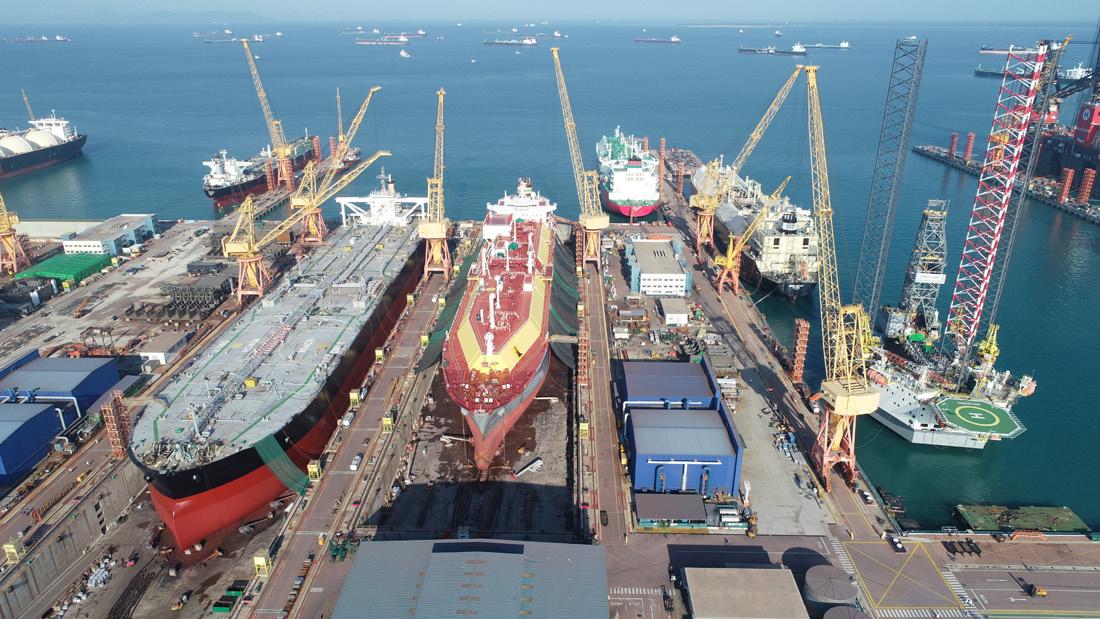By Michael Grey OBE
Dockgate
The essential salvor There can be little argument that last year’s dramatic grounding in the Suez Canal woke up the world to the fragility of the global supply chain. But it also alerted the perpetually complacent as to their dependence on the skills and technology of professional salvors – the only people who can untangle the mess that marine calamities produce. As this is being written, another team of salvors is energetically addressing the difficult job of refloating the Ever Forward, which buried herself at some speed in the mudbanks of the Delaware River in March and has proved very reluctant to leave this comfortable berth. And with car carriers listing dangerously and catching fire, both in port and at sea, big, disabled ships requiring assistance in hazardous places, regular containership fires and complex wreck removals, there seems plenty of evidence that salvors still provide an essential emergency service. The regular meetings of the International Salvage Union invariably provide something of a window into the salvor’s concerns and operations. March saw the London ISU Associate Members’ Day, thankfully in-person after a lengthy Covid-driven interval. So, what is occupying the minds of these skilled maritime practitioners? For some years the ISU has made a habit of reporting on the quantity of pollutants that have not entered the marine environment, because of its member’s endeavours. In 2021, there were 226 services to vessels which had been carrying 2.6m tonnes of potentially polluting cargo. You can debate about the validity of such a claim, but the fact that the pollution did not happen, when it might have done, is surely not unreasonable. And while people’s minds automatically focus on oil, (witness the idiotic demonstrators on the streets), tankers, which are arguably the best run ships at sea today, are not the biggest concern for the salvors. Services to containerships, carrying more than 100,000 teu represented the most significant ‘growth’ in the statistics, with all manner of dangerous goods, chemicals, and the more recently recognised menace of plastic pellets, not entering the sea, because of the salvors’ efforts. There were reports about places of refuge, and a review designed to make the Lloyd’s Open Form a more acceptable document and a better mechanism for making salvage awards less of a tortuous business. It was suggested that there was a need for a global acceptance of salvage
The Costa Concordia was dismantled in Italy
The Ever Forward aground in the Mississippi
awards, and much more collaboration and trust between all involved parties. If salvors are to extend themselves with huge costs during a complex salvage, shouldn’t they be paid something on account? You would think by now that we would not learn of casualties where lives and the environment have been put at risk by the masters of ships delaying that important call for tugs and the emergency services, while waiting for permission from their managers. In one case, there was a 10-hr delay, while this to-ing and fro-ing went on, with the ship eventually grounding, and this is not an isolated case. Such delays, it is emphasised, invariably make the situation worse, and an independent report into this dangerous and avoidable problem has been commissioned. It will be no surprise to learn that the investigation revealed that ‘financial considerations’ predominate in these emergencies, with the crew safety, welfare and the environment less of a concern to the bean-counters. The perception that the LOF - which ‘removes the agony of the moment’ - was always expensive, was a view that required to be confronted. The growing list of liabilities to which salvors find themselves having to accept in this litigious age is a perennial problem, which is getting ever worse. “Is it safe for the salvor to go to work?” asked US salvor John Witte, considering personal liabilities, third party liabilities, economic damage liabilities and the cost of insuring against all these, in addition to what one might think of as the primary risks of the salvors’ normal work. Should the salvor be liable, just because of being on site, when there was loss of life, for which he had no conceivable responsibility? There doesn’t seem to be a great deal of fairness in US interpretations of the law. I recall a case of a ship in a US anchorage where the crew saw a sailboat capsize in a squall and put their boat in the water, ultimately saving one of the two occupants, although the other, rescued by the Coastguard, sadly succumbed. Months later the Hong Kong owner of the ship found that he was being sued by the relatives of the deceased, and his US lawyers, to his considerable anger, were advising him to settle. These are now real-world concerns about liabilities that no salvor can afford to ignore, even if such cases stretch both reason and common sense. The ‘technology slot’ in the ISU event was given to an exposition of Dyneema Fibres, something that emerged in a laboratory many years ago and has morphed from a useful protective material to incredibly light and versatile spun fibre now found in rope, nets, heavy lifting nets, synthetic chains and protective clothing. With far less weight than the steel materials
Volume 20 Issue 1 – Page 73












